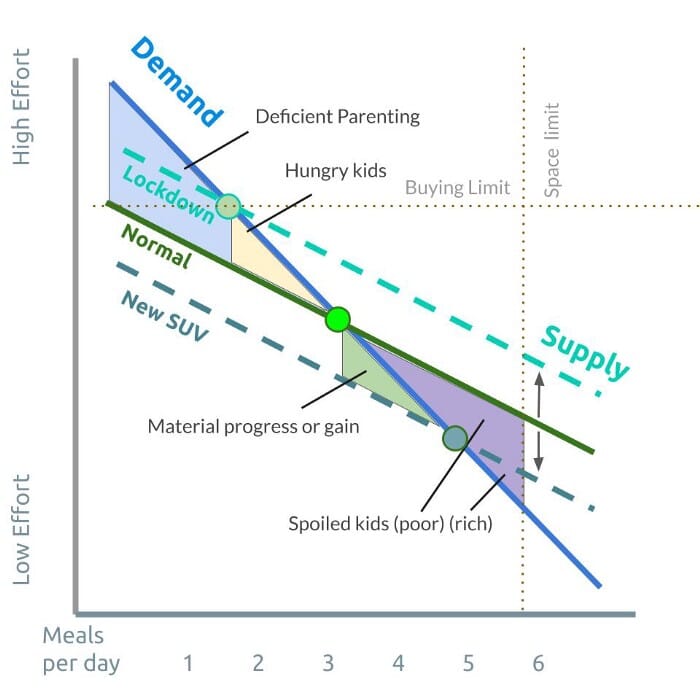Family Efficiency Model
The previous section explained Supply and Demand Efficiency and Inefficiency.
- Efficiencies are called surpluses in Economics
- Inefficiencies are called losses, like deadweight loss
We can create their Supereconomic equivalents, using our effort theory of value, so that they can be applied to families, organizations, etc (ours is a socio-economic system, with more features than an economic system such as Capitalism and Communism):
| Name | |
|---|---|
| Producer’s surplus — a state where the producer gets more gain. Examples are families where parents neglect their children, or a company where the employer gets way more benefit than the employees |

|
| Deadweight loss — a state where the society labours harder than usual for less gain. For example, when a natural disaster cuts the family’s water supply so that they have to go the river to fetch it manually |

|
| Consumer’s surplus — a state where the consumer gets more bargain or advantage. Examples are families where parents are overworked or a company where the employees are lazy and feed off a hardworking boss |

|
| Manageable balance — a state where both get equitable share |

|
| Material progress — a state where society labours less for more gain. An example is a family buying a computer to get more work done or get more entertainment |

|
A Family Scenario (May 2020)
A single father (supplier) with two children (demanders) normally supplies his family with 3 meals a day by using public transport.

- A Covid crisis hits and his country goes on lockdown (new regulation) and imposes limits on purchases (ceiling), reducing the meals to 2 per day, leading to hungry kids (deadweight loss)
- After a month, the lockdown is eased and the father is able to buy a vehicle (material progress) to be able to bring more food with less effort, which then leads to spoiled kids.
- Poor families have limited space as tiny houses (environmental limits) preventing the accumulation of food, which reduces the probability of having spoiled kids.
Superphysics uses its own Effort theory of value instead of Marginal pricing theory of Economics Through this tool, the policymakers of a society, whether a father of a house, or a prime minister of a country, can choose the right policy from their arsenal in order to create a desired outcome. Do they increase limits to prevent externalities? Or do they subsidize technology and reduce limits to create progress and growth?
Singularized Demand and Supply, with Deadweight loss and Material gain
The previous curves showed demand and supply arriving at a balance or ’the tao’ by trial and error. The Tao represents the highest quantity of goods at the lowest prices, while being within the environmental limits:

In the future, this tedious process can be solved by machine learning which will coordinate supply to meet demand in real time. This will “singularize” both curves into one:

Deadweight loss and material gain will still manifest in such a curve. This is because, even though there is no more conflict between producer and consumer in a unified human species, there would still be a gap between the ideal (represented by absolute demand) and the actual reality.
In this example, assume that all humans agreed to be put under a single Earth government. Prosperity was optimized and secured at 5 output at 3 effort, or a total of 15 effort*.
*In our effort-theory of value, there would be no more need to objectify effort into currency nor precious metals.
If the government decided to mobilize human labour to colonize Proxima Centauri B by a tax that would force humans to add 2 more output at 1 effort, then it would create a new gross effort at 28, with a new imposition of 13 effort.

Most likely, the humans in this situation would instead develop new technology to save their toil, manifesting as the dotted line. So that for the same 7 output, the new gross effort would be 21.
After Proxima Centauri B is colonized, the new curve will slowly settle to its natural rate, possibly at 14 effort.